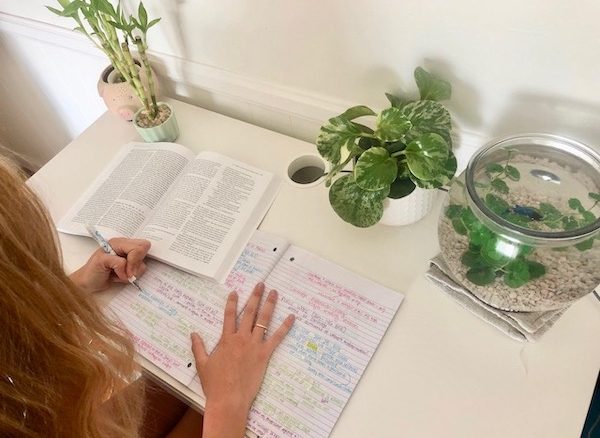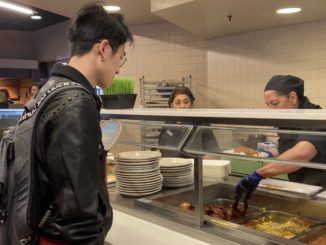
Freshman English major Cambria Acheson anxiously sat at her desk in her hometown of Fullerton, California, as she waited for admittance into a Zoom call.
With a single press of the keypad, her very first college experience began through a digital screen. Feelings of anxiety, disappointment and excitement set in as she started her college experience and tried to build a sense of community for herself online.
Acheson is one of 874 freshmen and transfer students who began their Pepperdine experience virtually. Although they are unable to compare the experience to in-person campus life, these new students mentioned feelings of eagerness, hesitation and gratitude when reflecting on their experience thus far. Administrators and student leaders have found inventive ways to help students integrate through virtual New Student Orientation training, club meetings, recreational offerings and social media engagement.
“When it first began, I was really eager to get involved with the college community, but I quickly discovered that it was gonna be a lot different than I expected,” Acheson said. “I wasn’t sure how to meet that challenge at first because I was going to my Zoom classes, but didn’t really get a chance to talk to classmates during the class.”
Administrators, program coordinators and new students have all searched for ways to engage with one another while battling new challenges of “Zoom fatigue.” NSO, the Transfer Student Alliance, The Student Programming Board and Pepperdine Greek Life contributed to the virtual community-building process. However, all groups, from students to administrators, worried whether this sense of community will falter as virtual learning persists.
Changes to NSO
Annually the schedule for NSO begins the week prior to fall classes starting, with most activities geared toward community integration. To address the online status of the semester, the program extended into a six-week virtual program where students and parents could get the information they needed in an organized structure.
“Now in the virtual world, how do we take this one week and make it so that all our campus partners can share their information,” said Danielle Minke, campus programs coordinator for Student Activities. “And students feel like they are having all this access but without being overloaded. That’s why we created these six weeks of NSO.”
Each weekly session addressed applicable topics that helped create shared experience for the students. These sessions included: Student Wellness, Life Outside the Classroom, Academics and Creating Connections. NSO leaders made the most convenient schedule for all students with recorded sessions so they could have the opportunity to watch them on their own.
“The Zooms were more information based,” Acheson said. “It was good to hear from people from administration and who are knowledgeable about different parts of it.”
Doug Hurley, associate dean of Student Affairs, said faculty and administration have centered their efforts on finding the best routes to reach students and help them have a strong outside of the classroom experience.
The NSO coordinators created new student small groups that received 239 sign-ups. Meanwhile, the Transfer Student Alliance developed the Transfer Family program with about 14 transfer families in total.
“They were assigned to four new transfers … that are getting together through Zoom or phone or text just to check in with the new transfers,” said Sergio Gallardo, student affairs intern for transfer and commuter students.
Orientation leaders and the Transfer Student Alliance took the time to offer informal virtual events through social media engagement and virtual coffee hours.
“We call it Transfer Thursdays Together,” Gallardo said.
Through their Instagram account, they share a prompt for students to participate in and repost any stories the account is tagged in, while also offering a prize for a random winner.
Student perceptions of new student groups and transfer alliance families
Before the virtual classroom environment began, the New Student Small Groups provided a space for students to interact with one another informally.
“That was my first experience where I got to talk and interact with people,” Acheson said. “I enjoyed that process and I love the social part of school, so being in that environment was encouraging.”
Hana Kim, freshman international business major, said she was able to make about five new friends from her meetings through a speed-dating replica activity utilizing breakout rooms.
“It was a nice opportunity to see if they click with that person,” Kim said.
Gallardo said he has received positive perceptions of the Transfer Student Alliance Families. In contrast, some transfer students found community without the help of the Transfer Student Alliance families.
“I signed up for the Transfer Student Alliance program, but I did not proceed to follow the steps,” said Lauren Amigleo, junior integrated marketing communication major.
Despite that, she said social media could entice her, as well as other transfers, to engage with the program more.
“Being inside all day and not having the opportunity on campus, I utilize social media more, and if they had a platform for transfer students … it would catch their attention,” Amigleo said.
Administrators’s perceptions on student community-building
For administrators and program coordinators, the focus on community building continued long after NSO. Minke described the challenge of meeting the community needs of students using a doorway metaphor.
“How many doors does it take to get to the common room, and each door is a physical barrier which makes it harder to program,” Minke said. “Now we are online, so you would think there are less doors but they still have their family and responsibilities they might’ve not had like chores.”
Administrators and program coordinators have seen positive effects from NSO and other subsequent activities
“It has been meaningful for those who stuck through the ride,” Minke said. “I think they were so needed. … We should have started it earlier because I think there was that need for students to connect.”
Additionally, Hurley said that even with the student life fee being reduced, programs are still able to actively engage students in virtual events.
“I don’t want to say I hope we can get better cause I don’t want this to last,” Hurley said. “But if we had to stay away from each other in the spring, I think we could be getting better and better at this.”
There were noticeable challenges with consistent attendance and engagement.
“There is always a bit of drop off,” Minke said. “It wears on you when people don’t consistently show up.”
The average number of participants for each of the live webinars was about 65, but this is a rough estimation as families could have all been viewing on one device, Minke said.
Administrators advised students eager to build community to reach out to faculty as well as other students to get connected or find out any information.
“Feel free to reach out to us as staff … totally fine saying that they are having trouble finding university communications,” Hurley said.
Contact information for staff and administration for Student Activities and the Transfer Student Alliance is available on the Pepperdine community website.
Many traditional Pepperdine community programs are in transition but still will follow through as planned. This includes Dance in Flight, Songfest and Waves Weekend.
“Don’t give up on these great traditions,” Hurley said. “They are just gonna look different.”
Student activities and class contributions
As more events happen throughout the virtual semester, event coordinators will be monitoring student engagement and feedback. Overall community building takes courage, students said.
“You have to encourage yourself, as you are alone, to build a community for yourself,” Amigleo said, reflecting on her participation with virtual sorority recruitment.
Social media assisted her experience as she found it less intimidating to reach out through Instagram direct messages to ask questions or get further contact since options are now limited.
The virtual classroom atmosphere provided students with the opportunity to engage with others via social media.
“Through my classes in general people are always willing to throw out their socials,” said Jaden Yeum, freshman economics and business major.
Similarly, Colin Wiese, a freshman IMC major, said his freshman seminar created “one big happy freshman family” through class time and consistent group chats.
Impacts of student programming events on community building
The Board and other programs utilized Peppervine, Instagram, Twitter and a newsletter to invite and inform students of their events, Annabelle Childers wrote in Sept. 20 Pepperdine Graphic article.
“Clubs are still very active on Peppervine,” Hurley said.
Acheson took to Peppervine and filled her calendar with club meetings and different virtual events. She specifically mentioned Alpha Omega, a student-led ministry group, as being very intentional in including her into the program and helping her find community.
“Personally growing in the fact that I’m getting involved in more things and kind of being pushed socially in a good way to be more intentional about my engagement with my college community,” Acheson said.
A Graphic survey found that first-year and transfer students were more likely to attend events compared to their upper-level peers, Childers wrote.
Acheson and Wiese both have participated in virtual student activities over the course of the semester so far. They specifically enjoyed their participation in the Board’s Family Feud Night.
The semester and the experiences of new students hoping to build community does not end with the closing of a laptop.
“Pepperdine is really persistent in a good way,” Yeum said. “I like how they put the students first.”
Megan Villaverde completed the reporting for this story under the supervision of Dr. Christina Littlefield and Dr. Elizabeth Smith in Jour 241 in Fall 2020. Dr. Littlefield supervised the web story.



